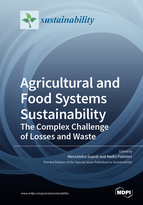Agricultural and Food Systems Sustainability: The Complex Challenge of Losses and Waste
A special issue of Sustainability (ISSN 2071-1050).
Deadline for manuscript submissions: closed (15 August 2022) | Viewed by 26328
Special Issue Editors
Interests: agricultural mechanization; agricultural residue management; biomass; bioenergy; industrial crops; environmental assessment; life cycle assessment
Special Issues, Collections and Topics in MDPI journals
Interests: consumer behavior; food science; willingness to consume; willingness to pay; agricultural economics; environmental and economic assessment; life cycle assessment (LCA); life cycle costing (LCC); costs benefits analysis (CBA)
Special Issues, Collections and Topics in MDPI journals
Special Issue Information
Dear Colleagues,
We are pleased to announce a Special Issue of Sustainability on “Agricultural and Food System Sustainability: The Complex Challenge of Losses and Waste”.
According to FAO (2018), one-third of the food produced globally is lost or wasted, which has environmental, economic, and social impacts on the overall food value chain and on society. Food loss and waste translate to economic losses for farmers and higher prices for consumers, both of which affect food insecurity by making food less accessible for the poorest and more vulnerable groups (FAO, 2018). The adoption of the 2030 Agenda for Sustainable Development (Goal 12—“Ensure sustainable consumption and production patterns”) calls for renewed efforts to reduce food losses along the production and supply chains. Achieving this goal also requires greater efforts globally in implementing food loss reduction policies and intervention. Although progress has been made in identifying the direct causes of food losses and quantifying their magnitude, there is a need to focus loss reduction strategies on technological solutions without overlooking the relevance of socioeconomic factors influencing the functioning of the food value chain.
In addition, at farm level, another aspect that appears to be of increasing importance is represented by the sustainable management and use of byproducts from agriculture, including agricultural residues (such as non-edible parts of vegetables’ plants, stalks or wood resulting from pruning, discarded fruits, and crops grown but not harvested).
For this Special Issue, we welcome conceptual and empirical studies that analyze actions:
- To reduce losses of products and byproducts at the farm level;
- To promote sustainable agriculture;
- To provide insights into the relationships between consumers and household food waste behaviors;
- To evaluate the market potential of food obtained from byproducts;
- To promote the reuse of waste and byproducts to increase the nutritional value of food;
- To underline causes of food waste and its correlation with climate change, agriculture, and population growth.
The papers must show originality and make a significant contribution to the scope of the Special Issue.
Dr. Alessandro Suardi
Dr. Nadia Palmieri
Guest Editors
Manuscript Submission Information
Manuscripts should be submitted online at www.mdpi.com by registering and logging in to this website. Once you are registered, click here to go to the submission form. Manuscripts can be submitted until the deadline. All submissions that pass pre-check are peer-reviewed. Accepted papers will be published continuously in the journal (as soon as accepted) and will be listed together on the special issue website. Research articles, review articles as well as short communications are invited. For planned papers, a title and short abstract (about 100 words) can be sent to the Editorial Office for announcement on this website.
Submitted manuscripts should not have been published previously, nor be under consideration for publication elsewhere (except conference proceedings papers). All manuscripts are thoroughly refereed through a single-blind peer-review process. A guide for authors and other relevant information for submission of manuscripts is available on the Instructions for Authors page. Sustainability is an international peer-reviewed open access semimonthly journal published by MDPI.
Please visit the Instructions for Authors page before submitting a manuscript. The Article Processing Charge (APC) for publication in this open access journal is 2400 CHF (Swiss Francs). Submitted papers should be well formatted and use good English. Authors may use MDPI's English editing service prior to publication or during author revisions.
Keywords
- Consumer behavior
- Food waste
- Food byproduct
- Waste-to-value (WTV) products
- Consumers’ acceptance
- Agricultural residue
- Harvesting losses
- Food crops
- Industrial crops
- Sustainable agriculture







